Palaeolithic (Prehistoric) | Anthropology Optional for UPSC PDF Download
Palaeolithic Culture
- Man faced great climatic changes during the period of his development but his highly developed, complex and intelligent brain helped him to invent tools, to face climate fluctuations and to continue to live. He had to work hard to get food. In the initial stages he was merely food gatherer . He learned, to join his fellow men and go in search of the fruits and games that nature provided. He learned to make tools of stone, use animal skins for clothes and built shelter. He learned to make fire and developed the power for speech. But he still lived hunting, fishing and gathering edible roots, fruits and any other things that nature provided. This period in early man’s development is commonly known as old stone age or the Palaeolithic age. By definition the cultural debris recovered from the entire period of pleistocene (approximately 3 million years to 10,000 B.C.) is termed as Palaeolithic culture.
- Man has been living in India roughly for 500,000 years. The Palaeolithic culture of India developed in the Pleistocene period that comes immediately before the geological period Holocene or current period in which we live surd which began about 10,000 years ago. Scientists are not sure as to when Pleistocene period exactly began. The period was characterised by major climatic fluctuations. For thousands of years climate used to become so cold surd chilly that everything used to be frozen and big boulders of ice (glaciers) were formed. This phase has been termed as Glaciation. Thus Europe and America passed through four Glaciations and three Inter Glaciations (the periods of moderate climate in between two glaciations). However, the tropical regions, excepting the mountains, were free from ice. On the other hand they underwent period of great rainfall; interspersed by dry climate termed Pluvial and |Inter-Pluvial| respectively.
- The process of cultural development may be said to have started when our sub-human ancestors had acquired the skill to produce crude tools that often looked like stones chipped or shaped under natural conditions. Man was still in the process of evolution and was more or less of the status of Australopithecus africanus - a semi-erect ape like creature. Nearly a million years ago Homo erectus evolved and after words Homo sapiens or modern man came on the scene to conquer this earth. They were much better equipped to interact and hence adapt to ground living. Fire was also tamed by them at a later date. “Gathering around fire for equal traditional benefits may have been usually practised and this may have also helped in consolidating the social bonds in these early human bands” (Bhattacharya, 1984). The natural flaking might have suggested to man that he could also make stones into tools for different purposes. The earliest tool maker gradually learned just how to hold a piece of stone or rock and just how forceful a blow to deliver precisely at what angle in order to remove flakes of the right size from the desired spot.
- Robert Bruce Foot was the first to discover a Palaeolithic stone tool in India in 1863. Palaeolithic research in India is, therefore, more than a hundred years old. But it got a boost only with the coming of Yale-Cambridge Expedition in 1935 led by De Terra and Patterson.
- Till some time back Palaeolithic in India had only two divisions:
(i) Early Stone Age of Lower Palaeolithic
(ii) Middle Stone Age or Middle Palaeolithic - Since India did not have an independent character of Upper Palaeolithic like Europes’, the available scanty and fragile evidences of the Upper Palaeolithic were lumped with the Middle Palaeolithic. On the basis of several recently excavated sites an outline of Indian Upper Palaeolithic has definitely emerged though it is still not comparable with that we know as European Upper Palaeolithic. Thus in the present description of Palaeolithic in India has been described through the three familiar phases—Lower Palaeolithic, Middle Palaeolithic and Upper Palaeolithic.
Lower Palaeolithic
- Except for the northern alluvial corridor and Kerala, the archaeological evidences of Lower Palaeolithic have been found throughout India. However, no human fossils of so early a period have so far been discovered. In other regions, Palaeolithic tools been found from plateaus, river terraces, and even hilly slopes.
- The Indian Lower Palaeolithic can neither be arranged in any definite sequence or chronological order nor it should be considered as a uniform cultural stage. This is because of the fact that it’s character, in terms of time and cultural features, varies from region to region. The bulk of information we have of Indian Lower Palaeolithic is based on the study of the following sites: Soan valley located in Potwar plateau of north-west; Sabarmati Valley, Nagri, Chittorgarh and Didwana in Western India; Narsinghpur and Hoshangabad in Narmada Valley of Madhya Pradesh; Singrauli basin of Uttar Pradesh; Kuliana and Kamarpada in Orissa; Sisunia Hills of Bankura district in West Bengal; and Kurnool, Giddalur Karempudi Nagarjunakonda and Chingelpet in Peninsular India.
- The Soan valley is one of the most important sources of Lower Palaeolithic in India. Potwar is an elevated undulating land of about 100 sq. kms. lying between the rivers Indus and Jhelum. Rawalpindi (now in Pakistan) is located almost centrally in this region. Soan is a tributoiy of the river Indus whose valley (along with Kashmir region) was excavated by De terra and Patterson. Later on, some Indian prehistorians also excavated this region. The whole region demonstrates a predominance of chopper—chopping tools made on pebbles but at the same time some hand axes, and in relatively larger numbers, flakes have also been found. The Palaeolithic tools of the Soan valley may be divided into four main phases:
(i) Pre-Soan
(ii) Early Soan
(iii) Late Soan
(iv) Evolved Soan - The layer or stratum of the Pre-Soan has yielded a number of heavily rolled and blunted pebbles of quartzite rock. Most of these are split or broken and are of different shapes. The human workmanship of these ‘tools’ is doubtful because the presence of man in this region at such an early date is still not confirmed. It is still a matter of debate whether these heavily rolled and blunted pebbles are the handiwork of certain natural factors or the earliest manifestation of human workmanship. Many scholars put these ‘tools’ under the category of ‘Eoliths ’. The layers of the early-Soan have yielded very important tools. These are mainly two types of tools described as choppers and chopping tools. The only point of difference between these two is flaking on one/both sides.
When it is unificial it is chopper and when flaked from both the sides (bifacial), it is chopping tool. These are very crude looking tools and indicate the use pf a crude and unsophisticated technology in their fabrication. These must have been ‘generalized tools’ and beside cutting or chopping some other usages of these tools may also be thought of. Pre-Soan and Early Soan may be put under Lower Palaeolithic. The tools of Late Soan are not basically different from those of the Early Soan except that now tools were lighters and neater and flakes/flake tools increased in number. The layers of the Evolved Soan have also yielded blades and blade tools but their number is not large enough to indicate any radical change in the life style of the people. Hence, parallels from the European Upper Palaeolithic should also not be drawn because its’ European counterpart is characterized by the presence of blade tools and a large number of other tools made on bone and other non-lithic materials. - A very striking feature old Soan culture is the discovery of some hand axes and cleavers along with the chopper/chopping tools made on pebbles. Most of these handaxes and cleavers look heavily rolled said blunted. A site called Chauntra is considered unique in this respect. Such Sites have added an element of uniqueness to Indian Palaeolithic because nowhere in the world chopper/chopping tools of pebbles and handaxes-cleavers have been found together. Even in the Indian subcontinent chopper/chopping tools and handaxes-cleavers belonging to such an early date have not been found together except in, the Soan valley. It may be indicative of a co-existence of two different human populations in close proximity living with different tool technology and typology. But it cannot be substantiated in the absence of skeletal remains.
- Lately, the western region has also emerged as an important source of Palaeolithic culture in India. Excavations in Saurashtra and Rajasthan have opened new avenues of information. The Chambal valley has yielded a number of large Lower Palaeolithic tools. The excavation of Didwana near Jodhpur has yielded evidences of substantial human settlements.
Here, one comes across large deposits of chopper and chopping tools with some relatively large hand axes; significantly no cleavers have been found. . In Gujarat, Lower Palaeolithic sites have been found along almost all the rivers which indicates that the climatic
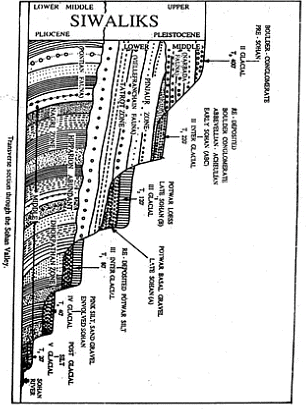 conditions were definitely conducive for human existence. Most of these tools closely resemble those of Acheulian tradition of European prehistory.
conditions were definitely conducive for human existence. Most of these tools closely resemble those of Acheulian tradition of European prehistory. The Narmada Valley of central India is also a very important source of Palaeolithic culture. After his experience from the Soan valley (characterized by the glaciation—inter-glaciation sequences) De Terra wanted to study central and peninsular India (characterized by the pluviation—inter-pluviation sequences) to have some idea of the effects of these two types of climatic fluctuations. Perhaps, Narmada region was the natural choice to study the effects of the different types of ecological conditions. The deposits, belonging to the Pleistocene, of Hoshangabad and Narsinghpur, have yielded good results. The whole of Narmada industry is characterized by large hand axes, cleavers, chopper/ chopping tools and Clactonian flakes. In the same region at the a place called Hathnora, a very important discovery has been made. It is a skeleton of Homo erectus that has now been designated as Narmada Man.
This is the only skeletal remain from the Lower Paleolithic in India. Though the deposits of Bhimbetka and Admagarh in Madhya Pradesh have also yielded Lower Paleolithic remains but the basic character of these two sites is of later cultural phases. The eastern region has also yielded some Palaeolithic sites mainly along its hilly rivers and hill slopes. The archaeological- research in this region is still in its infancy and nothing significant has come out except from 2-3 sites. From the Mayurbhanj district of Orissa, Kuliana and Kamarpada may be cited as such examples. These are large pits containing a rich collection of Lower Palaeolithic tools. Although no considerable stratigraphy has been found yet these archaeological remains throw important light on the life during Lower Palaeolithic in this region. More than half of these tools are chopper-chopping tools but these are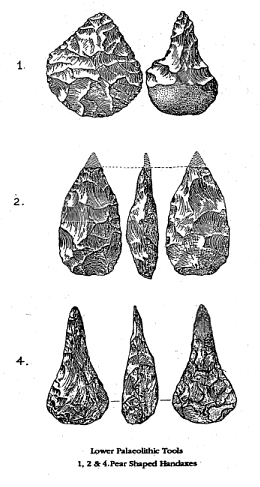
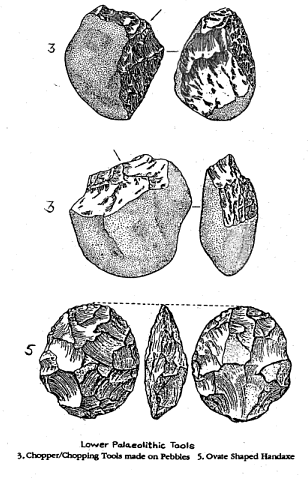 accompanied by some hand-axes and cleavers of Acheulian type. Beside these sites Lower Palaeolithic tools have also been reported from Bankura and Birbhum in West Bengal. Significantly, till now, all the Lower Palaeolithic sites of the extreme tip of eastern region are located in Meghalaya. Here, too, one comes across a predominance of chopper-chopping tools occasionally accompained by some handaxes and cleavers.
accompanied by some hand-axes and cleavers of Acheulian type. Beside these sites Lower Palaeolithic tools have also been reported from Bankura and Birbhum in West Bengal. Significantly, till now, all the Lower Palaeolithic sites of the extreme tip of eastern region are located in Meghalaya. Here, too, one comes across a predominance of chopper-chopping tools occasionally accompained by some handaxes and cleavers.The most important Lower Paleolithic industry after the Scan valley has been found from the peninsular India. Since such tools were discovered for the first time from the sites located in the erstwhile Madras estate, the whole industry has been designated as Madrasian Industry. Though dozens of sites, containing similar tools, have now been found from almost all parts of the country but traditionally it is still called as Madrasian industry. This whole region is tropical and comes under high rainfall regions of the country. For the first time in 1938, Lower Palaeolithic tools were found from the Kortaliyer valley of Chinglepet district in the present Tamil Nadu.
The whole Madrasian industry is characterized by a heavy preponderence of handaxes and cleavers. In later years some pebbles and flake tools have also been discovered from some sites like Gudiyam caves but the character of the Madrasian industry still heavily remains handaxe-cleaver which have been found in large numbers from dozens of sites.The hand axes and cleavers of the Madrasian industry look definitely more sophisticated and neatly made than those of the Soan valley. H. D. Sankalia has indicated the presence of waist on both the lateral edges of many handaxes and cleavers. This may be indicative of the practice of hafting tools in wooden or bamboo frames. It has opened new doors of research.
If the presence of hafting is substantiated this will be, perhaps, the earliest instance of hafting from anywhere in the world. In recent times the sites of Nagarjunakonda and Kareumpudi have yielded such large deposits of tools that Andhra Pradesh may rightly be described as the ‘treasure house’ of Lower Palaeolithic in India. Beside these, Malprabha, Ghatprabha and Tungbhadra from the Karnataka have also yielded a number of Lower Paleolithic sites but here too the pebble tools are conspicuous by their almost total absence like Kortaliyer valley’s sites.If a summation is done of the Lower Palaeolithic culture on the basis of the well studied sites, one may conclude that the Lower Palaeolithic culture must have emerged during the earliest days of the Upper Pleistocene epoch. Even this antiquity does not tell the whole story of the sub-continent because of regional variations. The sites of this period tell us about various religions and their respective climatic conditions where man had made his earliest habitations. The Lower Palaeolithic man usually lived near the source of water because of several reasons. In the absence of containers and utensils of storage of any type, they could not afford to make their settlements fair from the sources of water. That is why perhaps, most of the archaeological remains have been found from the river banks and valleys. The availability of raw material (mainly stone) must also have been an important determining factor in the location of settlements. They preferred to live near the deposits of pebbles and peripheries of forests (for the convenience in hunting). They never chose higher altitudes and dense forests for their habitations.
It is difficult to make any final comments on the use of tools fabricated by Palaeolithic man. Patterson has expressed the view with authority that the tools discovered from the Soan valley must have been meant for cutting and chopping, digging and skinning. Zeuner has opined that various types of handaxes of those times must have been used for digging out edible roots, cutting, boring and piercing, chopping and cleaving and skinning purposes. Man, during those times, used to live totally naked. He was food gatherhunter. Unfortunately we find tools of those times everywhere but no clues about the physical features of the tool maker. Perhaps, the highly acidic nature of Indian soil is responsible for this absence of fossil skeletal remains of that much antiquity. Chance or luck has also not favoured the prehistorians involved in the cultural construction of the past.
Middle Paleolithic
- Lower Paleolithic gave way to Middle Palaeolithic all over the world. For quite some time it was not considered an independent cultural phase. The reason was the absence of any definite stratigraphy without which it was difficult to draw a line of demarcation between the Lower and the Middle Palaeolithic. The earliest date of this cultural phase is dated around 1,00,000 B.C/ and it continued till around 30,000 B.C. Neanderthal man is believed to have dominated this stage of human evolution.
- There was hardly any clue to the existence of Middle Palaeolithic in India till about 1960 after which only it was recognised as a separate cultural stage. Credit goes to H. P. Sankalia, for establishing the independent existence of this cultural pha§e, who through his excavations at Navasa in 1956, was able to achieve this breakthrough. During this excavation a number of flake tools, belonging to the Middle Palaeolithic, were discovered.Incidentally most of the important sites of Middle Palaeolithic happen to be in Maharashtra region and especially the river valleys of Godavari and its various tributaries. Among such sites are Nevasa, Suregaon, Bel Pandhari and Nandur Madhmeshwar. The recent excavations in West Bengal have added the names of Bankura and Purulia in this list; Madhya Pradesh is yet another addition.
- A striking feature of Indian Middle Palaeolithic that has drawn the attention of many archaeologists is the change in raw material for tool making when the Lower Palaeolithic gave way to Middle Palaeolithic. Earlier it was mostly quartzite stone but for the first time tools were made on such smooth and bright rocks as flint and to a lesser extent on jasper and chalcedony. The Middle Palaeolithic tool maker was dependent upon flakes. The result of this shift from core to flake was smaller and lighter tools. These were mainly used as knives or other cutting tools. Perhaps, the present knives made on iron, steel etc. own their origin to these flake knives.
- In Madhya Pradesh and Bundelkhand region the Middle Palaeolithic culture can be seen in its best, and richest form. That is why the excavated sites of this region are considered as the best representatives of the Middle Palaeolithic. From sites of this region are considered as the best this whole region the cultural remains of Middle Palaeolithic have been discovered from the deposits of Narmada, Betwa, Shivni, Chambal, and other rivers and tributaries. Such cultural remains include small handaxes made on chert, cleavers, choppers and hundreds of flake tools; among the flake, tools different types of scrapers may be considered as representative tools. Bhimbetka in the Vindhyachal of Madhya Pradesh is another very important name whose slopes and rock shelters/caves contain a rich collection of various types of cultural remains. An eminent archaeological anthropologist V. N. Misra has done very important work in Bhimbekta.
Among the 700 odd rock shelters/caves in this region around 200 are located on Bhimbetka hills alone. About 500 of the total rock shelters contain different types of paintings. This region is considered to be the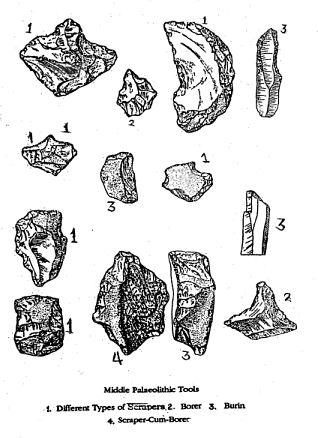 richest in the world in terms of number of painted rock shelters/caves. In one of the excavated sites (IIIF-23) which measures 52 sq. mts. archeological material has been found upto a depth of four meters which can be divided into eight layers; layers 6 to 8 are later Acheulian (Lower Palaeolithic in the Indian context); the fifth layer yields Middle Palaeolithic tools; the fourth is Upper Palaeolithic. It is obvious that the tools were made in the rock shelter as evidenced by the presence of fabrication debris. The material used throughout was orthoquartzite for making hand axes and cleavers; the other tools were made on yellowish quartzite which withers faster. About five thousand tools were recovered from this site. Unfortunately, nothing has survived of the organic remains; no bones have been found yet. Lately, the Belan river valley in Allahabad (Uttar Pradesh) has also yielded substantial number of tools of this Culture.
richest in the world in terms of number of painted rock shelters/caves. In one of the excavated sites (IIIF-23) which measures 52 sq. mts. archeological material has been found upto a depth of four meters which can be divided into eight layers; layers 6 to 8 are later Acheulian (Lower Palaeolithic in the Indian context); the fifth layer yields Middle Palaeolithic tools; the fourth is Upper Palaeolithic. It is obvious that the tools were made in the rock shelter as evidenced by the presence of fabrication debris. The material used throughout was orthoquartzite for making hand axes and cleavers; the other tools were made on yellowish quartzite which withers faster. About five thousand tools were recovered from this site. Unfortunately, nothing has survived of the organic remains; no bones have been found yet. Lately, the Belan river valley in Allahabad (Uttar Pradesh) has also yielded substantial number of tools of this Culture. - If one wishes to describe, in concise form, the tools of Middle Palaeolithic culture one may say that due to their respective predominance in different regions the following may be considered as the representative tools; different types of scrapers, point, borer, burin, handaxe, cleaver along with some chopper-chopping tools and some blades. The presence of scrapers and borers has been disturbing many scholars. They wonder as to what a food gathering-hunting people had been doing with such tools in their food gathering economy. H. D. Sankalia has expressed the view that perhaps these tools were used in fabricating some other tools made on such material as wood, bone, horn etc., since non-lithic materials of this have not survived, so such tools. If this view is substantiated through concrete evidences then this controversy, too, may come to an end.
- On the basis of available evidences one can conclude that man, still, was totally dependent on
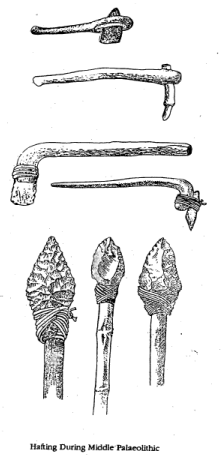 nature although he had acquired the knowledge of fire. They also lived in caves and did hunting in groups.
nature although he had acquired the knowledge of fire. They also lived in caves and did hunting in groups.
Upper Palaeolithic
- The Upper Palaeolithic culture coincided with the last phase of the Great Ice Age. Now the climate became comparatively warm. The Upper Palaeolithic age is authored by the fully evolved human race viz. Homo sapiens. It is almost certain that the previous evolutionary stages like the variety of the Neanderthals were totally wiped out by this fully grown human group. The early Homo sapiens were called Cromagnon man after the name of the site in France where it was first recovered. Both, culturally as well as biologically, these early human groups slowly differentiated to form different human races with their distinct cultures. The major developments of this period, besides the demise of the Neanderthals and the appearance of ‘modern mari, can be summarised as follows:
(i) ‘The expansion of humans into most of the worlds’ inhabited areas including the New world and Australia.
(ii) The relatively sudden and widespread appearance of figurines (especially female figurines) and other artifacts reflecting art and rituals.
(iii) The appearance of a wide range of bone tools including eye needles, harpoons, and other fishing tools.
(iv) There was a decided step towards organizing human groups in closely tied kinship organization,” (D.K. Bhattacharya, ibid). - On the basis of the above description (which is the portrayal of European Upper Palaeolithic of which we know a lot) it can be said that even today the Indian Upper Palaeolithic cannot be compared with its European counterpart as an independent and clearly distinct cultural stage. Obviously, sometimes scanty and some other times almost total absence of the above described cultural features is the main reason for this.
- Among the not too many Upper Palaeolithic sites on which we base most of our knowledge of Indian Upper Palaeolithic, the sites of Renigunta (Chittor, Andhra Pradesh), Mutchtala Chintamani Gavi (Kumool, Andhra Pradesh), Bhimbetaka and Bagor (Madhya Pradesh) and ftelan valley (Allahabad Uttar Pradesh) may be considered very important. Renigunta has yielded a large number of blades that are often regarded as representative tools of the Upper Palaeolithic. Among such blade tools are burins, awls, scrapers, borers, point and small choppers. The cave site of Mutchtala Chintamani Gaval occupies a special place among the above mentioned sites.
- The first bone tools have been discovered, from this site. Not only that, the richness of the site can be imagined by the fact that more than 90% of the tools found at this site consist of bone tools. Among such tools made on bone, horns and other non-lithic materials are scrapers, chisels, borers, barbs and spatula. The site at Belan valley, besides other artifacts, has also yielded a ‘female figurine’ made on bone. Similar figurines known as venus have been found in abundance from many European Upper Palaeolithic sites. But some scholars have created doubt over its nature by describing it as a fishing harpoon. If this is finally proved to be a venus like figurine, it will be the first object of this type from the Indian Upper Palaeolithic. Recently a site belonging to the Upper Palaeolithic has also been discovered from Bagor. The most striking feature of this site is that not only it is a habitation site, it also looks like a worshipping place.
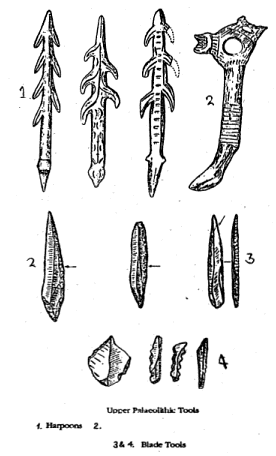
- This cultural phase, world wide began around 36.000 B. C. and came to an end around 9,000 B. C. “It has a duration of barely 27,000 years or so which is less than 3% of the duration of the Lower Palaeolithic age and 6% of the duration of Middle Palaeolithic phase” (Bhattacharya, ibid). An important fact that can be drawn from it is that in this journey of cultural evolution the more man advanced, the less duration of the coming cultural phase of increasingly important and radical cultural achievements. Sadly, our knowledge of the Indian Upper Palaeolithic is till far from adequate.
|
209 videos|299 docs
|
FAQs on Palaeolithic (Prehistoric) - Anthropology Optional for UPSC
| 1. What is Palaeolithic culture? |  |
| 2. How long did the Palaeolithic period last? |  |
| 3. What were the main characteristics of Palaeolithic culture? |  |
| 4. How did Palaeolithic humans obtain their food? |  |
| 5. What is the significance of Palaeolithic cave paintings? |  |

















